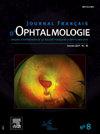Évaluation du dépistage ophtalmologique en milieu hospitalo-universitaire
IF 1.2
4区 医学
Q3 OPHTHALMOLOGY
引用次数: 0
Abstract
Objectif
Évaluer la faisabilité et l’utilité d’une consultation de dépistage ophtalmologique, sans rendez-vous, en première intention, dans un service hospitalo-universitaire.
Matériel et méthodes
Étude prospective d’une cohorte de patients consécutifs tout venant se présenter dans le service d’ophtalmologie du centre hospitalier intercommunal de Créteil sans rendez-vous, entre janvier 2022 et décembre 2022. Les patients inclus ont bénéficié du programme complet incluant la réfraction, la kératométrie, la tonométrie, la pachymétrie la mesure de l’angle irido-cornéen, la topographie cornéenne, la rétinophotographie et une photographie du pôle antérieur, à l’aide de la machine Visionix VX650. Pour tous les patients inclus, une mesure de l’acuité visuelle, une interprétation des données et un examen à la lampe à fente ont également été réalisés. Selon les éléments retrouvés, les patients inclus ont parfois bénéficié d’examens complémentaires.
Résultats
Au total, 536 patients (1072 yeux) ont été inclus dans cette série, avec une prédominance féminine 375/536 (70 %) et un âge moyen de 51,3 ± 4,5 ans. Parmi les patients inclus, 332/536 (61,94 %) ont présenté des éléments ophtalmologiques qui ont nécessité soit un traitement, soit une exploration ophtalmologique, principalement de découverte fortuite. Les examens complémentaires les plus couramment réalisés étaient l’OCT maculaire et RNFL (274/536 patients ; 51,11 %). Nous avons également observé une prévalence significative de la cataracte et une opacification du cristallin chez 53/536 (9,88 %), des troubles de la surface oculaire 52/536 (9,70 %) et des maculopathies liées à l’âge 36/536(6,71 %). 15 patients sur les 64 présentant des opacifications du cristallin ont pu être opérés. Le dépistage a également permis de dépister des suspicions de glaucome à angle ouvert 23/536 (4,92 %) et de la confirmer dans 12/536 (2,23 %) cas.
Conclusion
Le dépistage ophtalmologique réalisé dans le milieu hospitalier s’est révélé efficace et ouvre la voie à des possibilités consultation de premier recours sans rendez-vous en ophtalmologie. Au total, 332/536 (61,94 %) des patients avaient une pathologie ophtalmologique et la réalisation de ce bilan dans un cadre médical a permis d’initier une prise en charge efficiente sans délai.
Objective
To evaluate the feasibility and utility of an unscheduled first-line ophthalmological screening consultation in a university hospital setting.
Material and methods
This was a prospective study of a cohort of consecutive patients presenting to the ophthalmology department of Créteil Intercommunal Hospital without an appointment, between January 2022 and December 2022. The included patients received the complete protocol, including refraction, keratometry, tonometry, pachymetry, measurement of the irido-corneal angle, corneal topography, fundus photography and an anterior segment photograph using the Visionix VX650 machine. For all included patients, visual acuity measurement, data interpretation and slit lamp examination were also performed. According to the screening findings, the included patients then sometimes received additional examinations.
Results
A total of 536 patients (1072 eyes) were included in this series, with a female predominance 375/536 (70%) and a mean age of 51.3 ± 4.5 years. Among the included patients, 332/536 (61.94%) presented ophthalmological findings which required either treatment or ophthalmological investigation, most of which were incidental findings. The most commonly performed additional examinations were macular and RNFL OCT (274/536 patients ; 51.11%). We also observed a significant prevalence of cataract and lens opacities in 53/536 (9.88%), ocular surface disorders in 52/536 (9.70%) and age-related maculopathy in 36/536 (6.71%). Fifteen of the 64 patients with lens opacities were able to undergo surgery. The screening also made it possible to detect suspected open-angle glaucoma in 23/536 (4.92%) and to confirm it in 12/536 (2.23%) cases.
Conclusion
Ophthalmological screening carried out in the hospital environment has proven to be effective and paves the way to possibilities for unscheduled first-line ophthalmology consultation. In total, 332/536 (61.94%) of the patients had an ophthalmological pathology, and carrying out this assessment in a medical setting made it possible to initiate efficient treatment without delay.
大学医院眼科检查评价
目的评估在医院-大学部门进行无预约眼科检查的可行性和效用。材料和方法对2022年1月至2022年12月期间未预约到Creteil市间医院眼科就诊的连续患者队列进行前瞻性研究。包括患者受益于完整的程序,包括屈光、角膜测量、张力测量、虹膜-角膜角度测量、角膜地形、视网膜照相和使用Visionix VX650机器的前极点照相。包括所有患者在内,还进行了视力测量、数据解释和狭缝灯检查。根据证据,纳入的患者有时受益于额外的检查。增长共计536人,患者眼睛(1072)也列入了这个系列,与一个由女性375/536(70%)和平均年龄为51.3±4.5岁。包括患者当中,332/536眼科()提交了内容为61.94那些需要治疗或者探索主要眼科、偶然的发现。最常见的补充检查是黄斑CT和RNFL(274/536例;51,11 %)。我们还观察到53/536例白内障和晶状体不透明(9.88%)、52/536例眼表面疾病(9.70%)和36/536例黄斑病(6.71%)的显著患病率。64例晶状体不透明患者中有15例可以进行手术。筛查还发现23/536例(4.92%)疑似开角型青光眼,12/536例(2.23%)确诊。在医院进行的眼科检查已被证明是有效的,并为无需眼科预约的第一次咨询开辟了道路。共有332/536名患者(61.94%)患有眼科疾病,在医疗环境中进行这一评估可以立即开始有效的治疗。目的:评估在大学医院环境中不定期的一线眼科检查的可行性和实用性。这是一项前瞻性研究,研究对象是2022年1月至2022年12月期间未预约到Creteil社区间医院眼科就诊的连续患者队列。纳入的患者接受了完整的方案,包括屈光、角膜测量、色调测量、虹膜-角膜角度测量、角膜地形、基础摄影和使用Visionix VX650机器的前段摄影。在所有患者中,还进行了视觉敏感度测量、数据解释和狭缝灯检查。根据筛查结果,纳入的患者有时会接受额外的检查。ResultsA共536例患者(1072只眼睛),女性占375/536例(70%),平均年龄51.3±4.5岁。在纳入的患者中,332/536(61.94%)有需要治疗或眼科调查的眼科发现,其中大多数是附带发现。最常见的附加检查是黄斑和RNFL OCT(274/536例;51.11%)。我们还观察到白内障和晶状体不透明度在53/536(9.88%)、眼表面障碍在52/536(9.70%)和年龄相关黄斑病在36/536(6.71%)的显著患病率。在64例晶状体不透明患者中,有15例能够进行手术。筛查也使23/536(4.92%)疑似开角青光眼成为可能,并在12/536(2.23%)确诊。结论:在医院环境中进行的眼科筛查已被证明是有效的,并为不定期的一线眼科咨询铺平了道路。总的来说,332/536(61.94%)的患者有眼科病理,在医疗环境中进行这一评估,可以立即开始有效的治疗。
本文章由计算机程序翻译,如有差异,请以英文原文为准。
求助全文
约1分钟内获得全文
求助全文
来源期刊
CiteScore
1.10
自引率
8.30%
发文量
317
审稿时长
49 days
期刊介绍:
The Journal français d''ophtalmologie, official publication of the French Society of Ophthalmology, serves the French Speaking Community by publishing excellent research articles, communications of the French Society of Ophthalmology, in-depth reviews, position papers, letters received by the editor and a rich image bank in each issue. The scientific quality is guaranteed through unbiased peer-review, and the journal is member of the Committee of Publication Ethics (COPE). The editors strongly discourage editorial misconduct and in particular if duplicative text from published sources is identified without proper citation, the submission will not be considered for peer review and returned to the authors or immediately rejected.

 求助内容:
求助内容: 应助结果提醒方式:
应助结果提醒方式:


